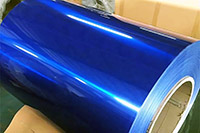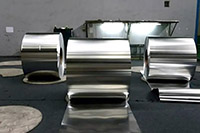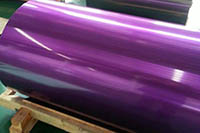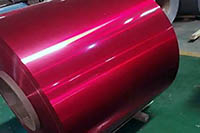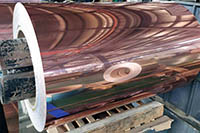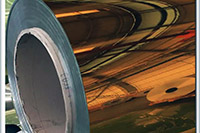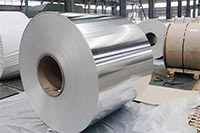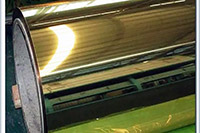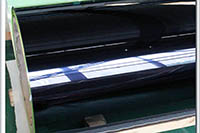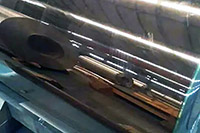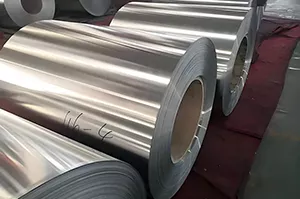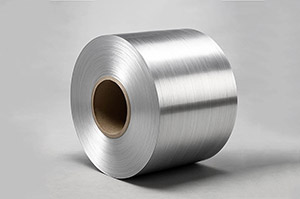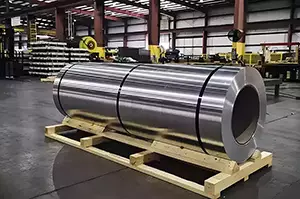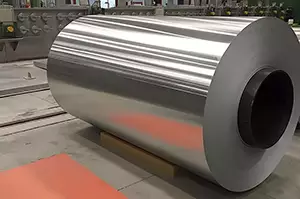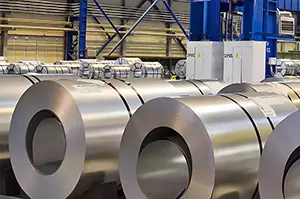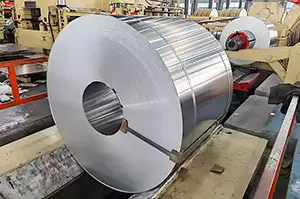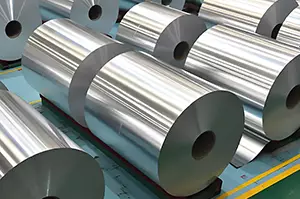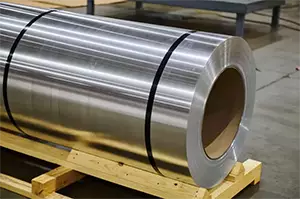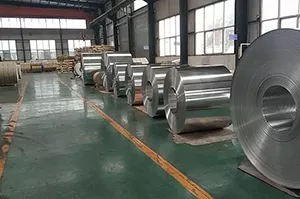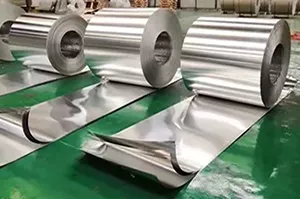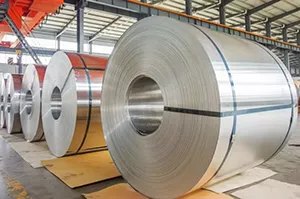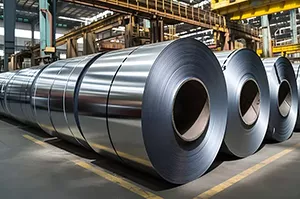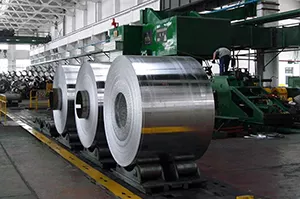3003 Aluminum Coil
3003 aluminum coil is an aluminum-manganese alloy, belonging to the 3000 series (or 3xxx series). This alloy cannot be strengthened by heat treatment but can be improved through cold working. Like other aluminum-manganese alloys, 3003 aluminum coil has moderate strength, good machinability, and excellent corrosion resistance.
Common processing methods for 3003 aluminum coil include rolling and extrusion, but it is not suitable for casting. It is widely used in applications requiring good formability and weldability, such as gutters, downspouts, roofing, and wall panels.
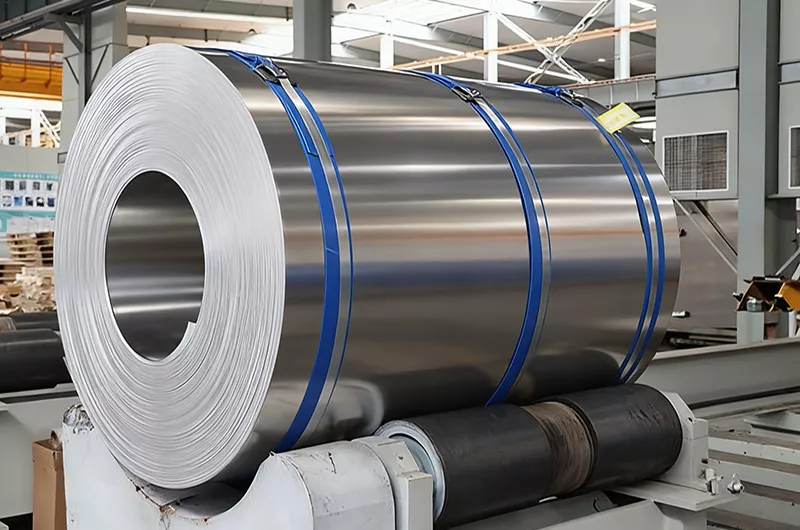
3003 aluminum alloy is a widely used aluminum-manganese alloy that offers higher strength and better corrosion resistance compared to the 1100 alloy. It is suitable for various applications requiring excellent formability and weldability.
3003 aluminum coil is based on pure aluminum with the addition of 1.0–1.5% manganese, which significantly improves the material’s strength and corrosion resistance while maintaining lightweight characteristics (density approximately 2.73 g/cm³).
- Non-heat treatable: Strength is increased through cold working (strain hardening) rather than heat treatment.
- Main standards: ASTM B209, ISO 6361, and EN-AW 3003.
3003 aluminum coil is a widely used material, highly regarded for its adaptability across industries. Its combination of moderate strength, corrosion resistance, and ease of manufacturing makes it an indispensable material in applications ranging from construction to energy storage.
3003 Aluminum Coil Specifications
| Parameter | Specification Range |
| Thickness | 0.2 – 8 mm |
| Width | 100 – 2650 mm |
| Temper Options | O, H12, H14, H16, H18, H19, H22, H24, etc. |
| Surface Treatment | Mill finish, brushed, anodized, coated (PVDF/PE) |
| Protective Coating | Film or kraft paper to prevent scratches and moisture |
| Anodizing | Enhances corrosion resistance and supports color customization |
Typical Aluminum Coil 3003 Temper
3003 aluminum coil is available in a variety of tempers, including:
- O: Annealed, the softest temper state.
- H14: Strain-hardened to a half-hard temper.
- H16: Strain-hardened to three-quarter hard temper.
- H18: Strain-hardened to full-hard temper.
Typical sizes include thicknesses from 0.2 mm to 3.0 mm and widths from 600 mm to 2000 mm.
- 3003 H14 Aluminum Coil Partially hard, cold-rolled aluminum coil with good corrosion resistance and moderate strength; suitable for roofing, siding, gutters, and ductwork applications; easy to fabricate and form.
- 3003 H24 Aluminum Coil Strain-hardened aluminum coil offering a balance between strength and formability; excellent corrosion resistance for outdoor applications; commonly used in architectural panels, awnings, and HVAC ducts.
- 3003 O Aluminum Coil Fully annealed, soft aluminum coil with maximum formability; ideal for deep drawing, bending, and complex shapes; widely applied in kitchen utensils, beverage containers, and decorative panels.
- 3003 H18 Aluminum Coil Fully strain-hardened aluminum coil providing higher strength than H14 while maintaining good corrosion resistance; suitable for roofing sheets, siding, and exterior architectural components.
- 3003 H12 Aluminum Coil Quarter-hard aluminum coil with good combination of strength and ductility; resistant to corrosion; commonly used in roofing, cladding, and general sheet metal fabrication.
- 3003 H16 Aluminum Coil Three-quarter hard aluminum coil offering enhanced strength while retaining good corrosion resistance; typically used in siding, panels, and general outdoor architectural applications.
- 3003 H19 Aluminum Coil Fully hard aluminum coil providing maximum strength in the 3003 alloy series; corrosion resistant but less formable; used in structural panels, roofing, and applications requiring higher rigidity.
3003 Aluminum Coil Properties
- Corrosion Resistance: Excellent, especially resistant to atmospheric and chemical corrosion, suitable for outdoor and marine applications.
- Strength: Due to the addition of manganese, the strength of 3003 is approximately 20% higher than that of the 1100 series aluminum.
- Formability: High ductility, easy to form and shape. Very suitable for bending, stamping, and roll forming.
- Rust Resistance: 3003 has outstanding rust resistance, ideal for applications requiring durability.
- Weldability: Good weldability using conventional methods.
- Not Heat Treatable: Strengthened through cold working rather than heat treatment.
- Workability: High plasticity, easy to stamp, bend and form; good elongation in the annealed condition.
- Other Characteristics: Moderate thermal conductivity, lightweight (low density), recyclable and environmentally friendly.
- Lightweight: Density of 2.73 g/cm³, can improve fuel efficiency in automotive applications.
- Limitations: Poor machinability in hardened tempers, limited heat treatability.
- Cold Working: Mechanical properties can be improved through cold working, but not through heat treatment.
3003 Aluminum Coil Advantages
- Good weldability
- Good corrosion resistance
- Good formability
- Medium strength
- Good rust resistance
- Good plasticity
3003 Aluminum Coil Standards
- ASTM-B209
- EN-AW 3003/AlMN1Cu
- UNS A93003
- QQA 250/2
Types of 3003 Aluminum Coil and Surface Options
- Used in building facades and roofing, providing excellent corrosion resistance and long-lasting finish.
- Exterior panels and decorative trim, enhancing aesthetics and durability.
- Signage and architectural accents, often chosen for its anodized shine.
- Appliances and furniture surfaces, offering a protective and decorative layer.
3003 Color Coated Aluminum Coil
- Roofing and curtain walls, offering vibrant colors and weather resistance.
- Exterior building panels and cladding, enhancing aesthetic appeal.
- Interior decorative panels for furniture, partitions, and ceilings.
- Industrial equipment coverings where corrosion resistance is required.
- Decorative panels and reflective signage, offering high reflectivity.
- Furniture and interior accents where a premium appearance is desired.
- Architectural applications requiring shiny, visually striking surfaces.
3003 Brushed Aluminum Coil
- Elevator panels and interior decoration, offering a modern metallic look.
- Appliances and furniture surfaces, reducing visible fingerprints and scratches.
- Architectural panels and trim, providing durable decorative finish.
- Signage and display panels where texture enhances appearance.
- Elevator panels, decorative panels, and ceiling panels with textured patterns.
- Signage and advertising boards for aesthetic and anti-slip surfaces.
- Roofing sheets and cladding for industrial and decorative purposes.
3003 Corrugated Aluminum Coil
- Roofing and siding benefiting from lightweight strength and rigidity.
- Industrial panels and protective coverings for structures.
- Ventilation ducts and shelters, where structural stability is key.
3003 Coated Aluminum Coil
- Industrial equipment coverings, corrosion-resistant panels, and machinery surfaces.
- Exterior building panels and decorative trims.
- Protective coatings for architectural and structural applications.
3003 Laminated Aluminum Coil
- Packaging materials for food and consumer products.
- Appliance exteriors and decorative sheets.
- Protective and aesthetic panels in industrial and building applications.
3003 Mill Finish Aluminum Coil
- HVAC ducts and industrial fabrication requiring untreated aluminum.
- General metalworking applications with further processing.
- Cost-effective option for structural and decorative purposes.
3003 Painted Aluminum Coil
- Exterior building panels and decorative facades.
- Signage and advertising boards with durable finish.
- Roofing sheets and cladding requiring weather resistance.
3003 Pre-Coated Aluminum Coil
- Roofing, wall panels, and industrial decoration ready for immediate use.
- Ensures consistent color and finish across large projects.
- Reduces on-site coating time and labor.
3003 Pre-Painted Aluminum Coil
- Curtain walls and exterior decoration with ready-to-use pre-painted finish.
- Roofing sheets and cladding with wide color options.
- Convenient and aesthetically consistent for building applications.
3003 PVC Coated Aluminum Coil
- Appliances and decorative panels with scratch and corrosion resistance.
- Exterior building surfaces for enhanced durability.
- Protective coverings for industrial and construction purposes.
3003 Stucco Embossed Aluminum Coil
- Roofing, cladding, and elevator panels with textured stucco finish.
- Decorative surfaces hiding scratches and enhancing aesthetics.
- Industrial and architectural applications requiring anti-slip properties.
3003 Textured Aluminum Coil
- Interior and exterior decorative panels with various textures.
- Furniture surfaces and signage for aesthetic appeal.
- Protective panels combining beauty and durability.
3003 Wood Aluminum Coil
- Doors, window frames, and interior decoration with realistic wood grain finish.
- Exterior decorative panels combining aesthetics and corrosion resistance.
- Furniture and architectural accents replicating natural wood.
3003 Perforated Aluminum Coil
- Acoustic panels, sunshades, and ventilated building facades.
- Decorative panels with functional airflow.
- Industrial screens and partitions requiring lightweight strength.
3003 Brazing Aluminum Coil
- Heat exchangers, radiators, and HVAC components requiring brazing.
- Industrial equipment where strong joints are essential.
- Corrosion-resistant and heat-resistant applications.
- HVAC ducts and insulated panels for thermal protection.
- Cold storage units and industrial insulation applications.
- Combines corrosion resistance with energy efficiency.
3003 Fin Stock Aluminum Coil
- Heat exchanger fins, radiators, and air conditioning components.
- Offers high thermal conductivity and corrosion resistance.
- Lightweight and durable for efficient heat transfer.
- Stair treads, flooring, and truck beds requiring anti-slip surface.
- Platforms and industrial walkways for safety enhancement.
- Decorative and functional applications with corrosion resistance.
3003 Ultra-wide Aluminum Coil
- Roofing and wall panels for large-scale construction projects.
- Reduces seams and installation time for industrial and building applications.
- Ensures uniform finish and structural stability.
3003 Aluminum Trim Coil
- Window trims, door edges, and decorative profiles.
- Flexible, lightweight, and easy to cut or form.
- Durable finish suitable for interior and exterior use.
3003 Hot Rolled Aluminum Coil
- Industrial panels, roofing, and structural sheets requiring strength.
- Cost-effective solution for large-scale fabrication.
- Uniform thickness and high durability for heavy-duty applications.
3003 Cold Rolled Aluminum Coil
- Decorative panels, facades, and automotive components with smooth finish.
- Precise thickness and high dimensional accuracy.
- Corrosion-resistant, suitable for interior and exterior applications.
3003 Aluminum Coil Color Options
3003 Aluminum Coil Performance
- Higher strength than 1100, smooth surface, plasticity, and pressure resistance.
- The preferred sheet material for power battery shell, with impact resistance, not easy to break and leak, meeting the strength and rigidity requirements of power battery shell.
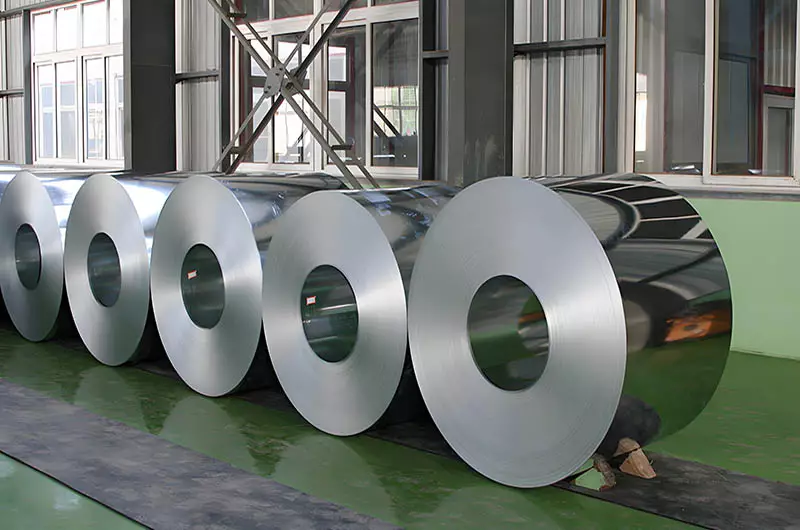
3003 Aluminum Coil Stock and Inventory
| Product Description | Temper | Thickness | Width | Form | Finish |
| 3003 H14 Mirror Aluminum Coil 0.016 x 36 | H14 | 0.016 in | 36 in | Coil | Mirror |
| 3003 H14 Mirror Aluminum Coil 0.020 x 36 | H14 | 0.020 in | 36 in | Coil | Mirror |
| 3003 H14 Mirror Aluminum Coil 0.032 x 36 | H14 | 0.032 in | 36 in | Coil | Mirror |
| 3003 H14 Mirror Aluminum Coil 0.032 x 48 | H14 | 0.032 in | 48 in | Coil | Mirror |
| 3003 H14 Mirror Aluminum Coil 0.032 x 60 | H14 | 0.032 in | 60 in | Coil | Mirror |
| 3003 H14 Mirror Aluminum Coil 0.040 x 36 | H14 | 0.040 in | 36 in | Coil | Mirror |
| 3003 H14 Mirror Aluminum Coil 0.040 x 48 | H14 | 0.040 in | 48 in | Coil | Mirror |
| 3003 H14 Mirror Aluminum Coil 0.040 x 60 | H14 | 0.040 in | 60 in | Coil | Mirror |
| 3003 H14 Mirror Aluminum Coil 0.050 x 48 | H14 | 0.050 in | 48 in | Coil | Mirror |
| 3003 H14 Mirror Aluminum Coil 0.050 x 60 | H14 | 0.050 in | 60 in | Coil | Mirror |
| 3003 H14 Mirror Aluminum Coil 0.063 x 84 | H14 | 0.063 in | 84 in | Coil | Mirror |
| 3003 H14 Mirror Aluminum Coil 0.063 x 36 | H14 | 0.063 in | 36 in | Coil | Mirror |
| 3003 H14 Mirror Aluminum Coil 0.063 x 48 | H14 | 0.063 in | 48 in | Coil | Mirror |
| 3003 H14 Mirror Aluminum Coil 0.063 x 60 | H14 | 0.063 in | 60 in | Coil | Mirror |
| 3003 H14 Mirror Aluminum Coil 0.080 x 36 | H14 | 0.080 in | 36 in | Coil | Mirror |
| 3003 H14 Mirror Aluminum Coil 0.080 x 48 | H14 | 0.080 in | 48 in | Coil | Mirror |
| 3003 H14 Mirror Aluminum Coil 0.080 x 60 | H14 | 0.080 in | 60 in | Coil | Mirror |
| 3003 H14 Mirror Aluminum Coil 0.080 x 72 | H14 | 0.080 in | 72 in | Coil | Mirror |
| 3003 H14 Mill Finish Aluminum Coil 0.090 x 36 | H14 | 0.090 in | 36 in | Coil | Mill Finish |
| 3003 H14 Mill Finish Aluminum Coil 0.090 x 48 | H14 | 0.090 in | 48 in | Coil | Mill Finish |
| 3003 H14 Mill Finish Aluminum Coil 0.090 x 60 | H14 | 0.090 in | 60 in | Coil | Mill Finish |
| 3003 H14 Mill Finish Aluminum Coil 0.090 x 72 | H14 | 0.090 in | 72 in | Coil | Mill Finish |
| 3003 H14 Mill Finish Aluminum Coil 0.100 x 48 | H14 | 0.100 in | 48 in | Coil | Mill Finish |
| 3003 H14 Mill Finish Aluminum Coil 0.125 x 36 | H14 | 0.125 in | 36 in | Coil | Mill Finish |
| 3003 H14 Mill Finish Aluminum Coil 0.125 x 48 | H14 | 0.125 in | 48 in | Coil | Mill Finish |
| 3003 H14 Mill Finish Aluminum Coil 0.125 x 60 | H14 | 0.125 in | 60 in | Coil | Mill Finish |
| 3003 H14 Mill Finish Aluminum Coil 0.125 x 72 | H14 | 0.125 in | 72 in | Coil | Mill Finish |
| 3003 H14 Mill Finish Aluminum Coil 0.160 x 36 | H14 | 0.160 in | 36 in | Coil | Mill Finish |
| 3003 H14 Mill Finish Aluminum Coil 0.160 x 48 | H14 | 0.160 in | 48 in | Coil | Mill Finish |
| 3003 H14 Mill Finish Aluminum Coil 0.249 x 48 | H14 | 0.249 in | 48 in | Coil | Mill Finish |
| 3003 H14 Mill Finish Aluminum Coil 0.190 x 48 | H14 | 0.190 in | 48 in | Coil | Mill Finish |
| 3003 H14 Mill Finish Aluminum Coil 0.190 x 60 | H14 | 0.190 in | 60 in | Coil | Mill Finish |
| 3003 H14 Painted Aluminum Coil 0.190 x 72 | H14 | 0.190 in | 72 in | Coil | Painted |
| 3003 H16 Painted Aluminum Coil 0.032 x 84 | H16 | 0.032 in | 84 in | Coil | Painted |
| 3003 H16 Painted Aluminum Coil 0.032 x 96 | H16 | 0.032 in | 96 in | Coil | Painted |
| 3003 H16 Painted Aluminum Coil 0.032 x 108 | H16 | 0.032 in | 108 in | Coil | Painted |
| 3003 H16 Painted Aluminum Coil 0.032 x 120 | H16 | 0.032 in | 120 in | Coil | Painted |
| 3003 H16 Painted Aluminum Coil 0.032 x 60 | H16 | 0.032 in | 60 in | Coil | Painted |
| 3003 H16 Painted Aluminum Coil 0.040 x 108 | H16 | 0.040 in | 108 in | Coil | Painted |
| 3003 H16 Painted Aluminum Coil 0.050 x 48 | H16 | 0.050 in | 48 in | Coil | Painted |
| 3003 H16 Painted Aluminum Coil 0.063 x 24 | H16 | 0.063 in | 24 in | Coil | Painted |
| 3003 H16 Painted Aluminum Coil 0.063 x 48 | H16 | 0.063 in | 48 in | Coil | Painted |
| 3003 H16 Painted Aluminum Coil 0.125 x 48 | H16 | 0.125 in | 48 in | Coil | Painted |
| 3003 H16 Painted Aluminum Coil 0.125 x 60 | H16 | 0.125 in | 60 in | Coil | Painted |
More Informations about Aluminum Coil 3003
- Processing: Aluminum Coil 3003 has good processability for an aluminum alloy.
- Heat Treatment: 3003 Aluminum Coil cannot be heat treated.
- Welding: This alloy has good weldability and is sometimes used with other aluminum alloys.
3003 Aluminum Coil Limitations
- Not heat treatable
- Low ductility
Equivalents of AA 3003
UNS A93003, ISO AlMn1Cu, Aluminium 3003, AA3003, Al3003
3003 Aluminum Coil Chemical Composition
| Composition | Si | Fe | Cu | Mn | Mg | Cr | Zn | Ti | Others-Each | Others Total | Al Min |
| 3003 | 0.6 | 0.7 | 0.05-0.20 | 1.0-1.5 | – | – | – | – | 0.05 | 0.15 | Remainder |
3003 Aluminum Coil Mechanical Property Limits
| Temper | Tensile Strength (MPa) | Yield Strength (MPa) | Elongation (%) | Key Applications |
| O (Annealed) | 95–140 | 35–70 | 15–25+ | Forming, deep drawing |
| H14 | 145–195 | 125–170 | 2–4 | Roofing, HVAC systems |
| H18 | ≥190 | ≥170 | 1–2 | High-strength structural parts |
| Temper | Specified Thickness(in) | Tensile Strength - KSI | Elongationin 2 inches % | |||
| Ultimate | Yield | |||||
| Min | Max | Min | Max | |||
| H12 | 0.017 - 0.019 | 17 | 23 | 12 | - | 3 |
| H12 | 0.020 - 0.031 | 17 | 23 | 12 | - | 4 |
| H12 | 0.032 - 0.050 | 17 | 23 | 12 | - | 5 |
| H12 | 0.051 - 0.113 | 17 | 23 | 12 | - | 6 |
| H12 | 0.114 - 0.161 | 17 | 23 | 12 | - | 7 |
| H12 | 0.162 - 0.249 | 17 | 23 | 12 | - | 8 |
| H14 | 0.009 - 0.012 | 20 | 26 | 17 | - | 1 |
| H14 | 0.013 - 0.019 | 20 | 26 | 17 | - | 2 |
| H14 | 0.020 - 0.031 | 20 | 26 | 17 | - | 3 |
| H14 | 0.032 - 0.050 | 20 | 26 | 17 | - | 4 |
| H14 | 0.051 - 0.113 | 20 | 26 | 17 | - | 5 |
| H14 | 0.114 - 0.161 | 20 | 26 | 17 | - | 6 |
| H14 | 0.162 - 0.249 | 20 | 26 | 17 | - | 7 |
| H16 | 0.006 - 0.019 | 24 | 30 | 21 | - | 1 |
| H16 | 0.020 - 0.031 | 24 | 30 | 21 | - | 2 |
| H16 | 0.032 - 0.050 | 24 | 30 | 21 | - | 3 |
| H16 | 0.051 - 0.162 | 24 | 30 | 21 | - | 4 |
| H18 | 0.006 - 0.019 | 27 | - | 24 | - | 1 |
| H18 | 0.020 - 0.031 | 27 | - | 24 | - | 2 |
| H18 | 0.032 - 0.050 | 27 | - | 24 | - | 3 |
| H18 | 0.051 - 0.128 | 27 | - | 24 | - | 4 |
| H19 | 0.006 - 0.063 | 29 | - | - | - | 1 |
| O | 0.006 - 0.007 | 14 | 19 | 5 | - | 14 |
| O | 0.008 - 0.012 | 14 | 19 | 5 | - | 18 |
| O | 0.013 - 0.031 | 14 | 19 | 5 | - | 20 |
| O | 0.032 - 0.050 | 14 | 19 | 5 | - | 23 |
| O | 0.051 - 0.249 | 14 | 19 | 5 | - | 25 |
Physical properties for Aluminim 3003
| Property | 3003 Data |
| Density, lb/in3 | 0.099 |
| Modulus of Elasticity, psi | 10.0 x 106 |
| Coefficient of Thermal Expansion, 68-212˚F, /˚F | 12.9 x 10-6 |
| Thermal Conductivity, Btu/ft hr ˚F | 112 |
| Specific Heat, Btu/lb ˚F | 0.213 |
| Electrical Resistivity, Microohm-in | 1.374 |
3003 Aluminum Coil Applications
The most common application of 3003 aluminum coil is for fuel tanks, sheet metal processing and other projects that require a stronger metal than 1100 series aluminum. In some cases, it is used in HVAC, hinges, condensers, radiators, evaporators, heat shields, gutters, downspouts, roof siding, cookers, refrigerator panels, gas pipes, storage tanks, garage doors, building hardware and awning slats, gasoline barrels, insulation, gas pipes, etc.
3003 aluminum coil is also used in mobile phone battery shells, lighting, interior decoration, air conditioning pipes, automobile fuel tanks, tanks, electrolytic capacitors and other fields.
The following industries often use 3003 aluminum coil:
- Construction: Roofing, curtain walls, wall panels, gutters, and downspouts, combining structural strength and weather resistance.
- Automotive: Panels, fuel tanks, car body panels, and trim parts.
- Marine: Hulls and other components exposed to seawater.
- Electrical: Cables, lighting fixtures, and enclosures.
- Consumer Goods: Cookware, utensils, furniture, storage tanks, and household appliances.
- Packaging Industry: Food containers, chemical piping, corrosion-resistant and safe for hygiene.
- Electronics & Power: Battery casings, heat sinks, meeting both conductivity and forming requirements.
Specific applications of this metal alloy include:
3003 H19 Honeycomb Aluminum Coil
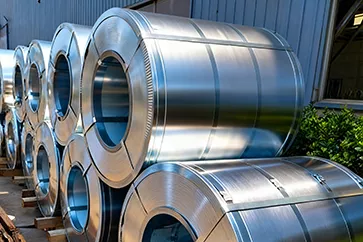
The 3003 alloy in the H19 temper is used in honeycomb structures due to its excellent strength-to-weight ratio and good corrosion resistance. Honeycomb panels made from 3003 are typically used in aerospace, automotive, and construction applications.
3003 Aluminum Coil for Lighting Fixtures
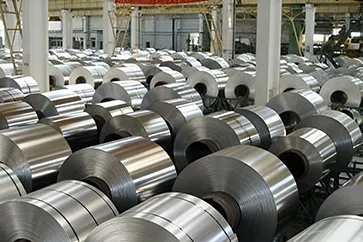
3003 aluminum is used in lighting fixtures because of its excellent formability and reflectivity. It can be easily stamped or rolled into various shapes needed for lighting components.
3003 Aluminum Coil for Automotive Interiors
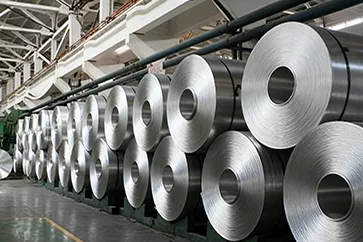
The 3003 alloy is used in decorative panels and dashboards for automotive interiors. Its combination of strength and formability makes it suitable for these applications.
3003 Aluminum Coil for Transformer Housings
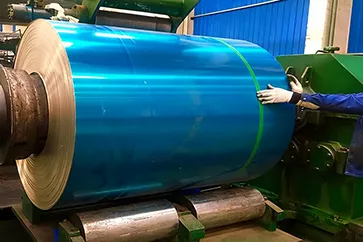
The corrosion resistance and thermal conductivity of 3003 aluminum make it an ideal choice for transformer housings, aiding in heat dissipation and protecting internal components.
3003 Aluminum Coil for Power Battery Housings
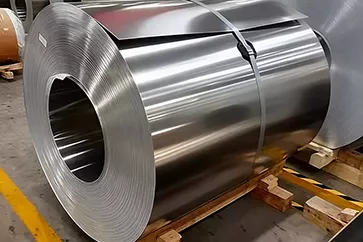
Similar to transformer housings, 3003 aluminum is used for battery casings due to its durability and heat resistance, providing protection during operation.
3003-H14 Insulation Aluminum Coil
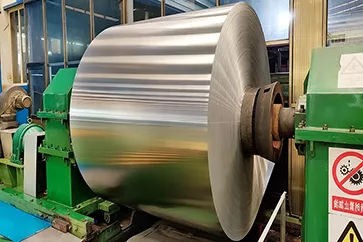
3003 aluminum coils are used in insulation applications due to their ease of forming and heat resistance. They are commonly used in HVAC systems and other thermal insulation applications.
3003 Aluminum Coil Production Process
- Melting and Casting: Aluminum ingots and manganese and other raw materials are melted at high temperatures in proportion to form a uniform aluminum liquid, which is then cast into ingots.
- Rolling Process: The thickness (0.2–10mm) and width (600–2000mm) of the aluminum coil are controlled through rolling processes to ensure a flat and smooth surface.
- Surface Treatment: Some products undergo color coating processes, with high-performance coatings applied to enhance aesthetics and functionality.
Related Questions
| Question | Answer |
| What is aluminium 3003 used for? | Aluminium 3003 is used in applications requiring moderate strength and good corrosion resistance, such as cooking utensils, heat exchangers, and storage tanks. |
| Difference between 3003 and 6061 aluminium? | 6061 aluminium has higher strength and better machinability compared to the more corrosion-resistant and formable 3003 aluminium. |
| Equivalent to 3003 aluminium? | An equivalent to 3003 aluminium is the AA3003 alloy under the same international designation system or similar grades like EN AW-3003 in European standards. |
| Difference between 1100 and 3003 aluminium? | 1100 aluminium is almost pure aluminum with excellent corrosion resistance but lower strength, while 3003 aluminium has a small addition of manganese which provides slightly higher strength and improved workability. |
| Difference between 3003 and 5052 aluminium? | 5052 aluminium offers higher strength and better corrosion resistance, especially in marine environments, compared to the more formable but less strong 3003 aluminium. |
| Can 3003 Aluminum Coil Be Anodized? | Aluminum coil 3003 can be anodized. It contains higher amounts of manganese which helps to protect the metal after anodization. However, the manganese content typically turns the resulting metal into an unattractive brown. |
Explore Different Aluminum Coil Grades
Further reading
- 3003 Aluminum Plate and Sheet
- 3003 h14 aluminum sheet
- 3003 h22 aluminum sheet
- 3003 o aluminum sheet
- 3003 Aluminum Disc Circle
Users viewing this material also viewed the following
- 3003 Aluminum Sheet Coil for Thermal Insulation Material
- Aluminum Tread Plate 3003
- 3003 Embossed Aluminum Sheet
- 3003 Aluminum Diamond Plate
- 3003 Hot-rolled Aluminum Plate
- 3003 Honeycomb Aluminum
- 3003 Aluminum Plate for New Energy Automobile Lithium Battery Power Battery Shell
- 3003+4343 Power Battery Cooling Plate
- 3003 Aluminum Plate for Brazing Water Cooling Plate
- Aluminum Brazing Composite Material 3003+4045 Aluminum Plate
- 3003 Aluminum Disc for Non-stick Pan
- 3003 Aluminum Plate for Mobile Phone Battery Shell
- 3003 Corrugated Aluminum Sheet
- 3003 Aluminum Plate for Automobile Fender
- 3003 Checker Aluminum Plate for Stair Anti-slip
- 3003 Tread Aluminum Plate for Cold Storage Floor Anti-slip
- 3003 Ultra-wide Curtain Wall Aluminum Plate
- 3003 Aluminum Plate for Building Decoration
- 3003 Roof Aluminum Plate for Decoration
Recommended Content
- What is 3003 aluminum used for?
- 3003 Aluminum Tubing
- 3003 Aluminum vs. 3005 Aluminum
- 3003-H18 Aluminum vs. 3005-H18 Aluminum
- What is the difference between 3003 H14 and 3105 H14?
- 3003 Aluminum vs. 3104 Aluminum
- 3003-H18 Aluminum vs. 3004-H18 Aluminum
- 3003-O Aluminum vs. 3004-O Aluminum
- What is the difference between 3003 and 3004 aluminum?
- 3003-H22 Aluminum vs. 3003-H24 Aluminum
- What is the difference between 3003 O and 3003 H14?
- What is the difference between 3003 H14 and H24?

